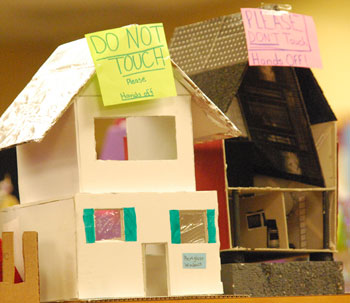As part of a city study of Ann Arbor’s sanitary sewer system, a citizens advisory committee met on Jan. 9, 2014. The meeting was about backups – in several different senses.

“Do not touch” reflects the attitude of some Ann Arbor homeowners toward their houses in the context of the city’s footing drain disconnection program. These class projects from Johanna Nader’s material science class at Slauson Middle School were on display at the Slauson media center. That’s where the most recent meeting took place for the city of Ann Arbor’s citizens committee that is advising the city’s sanitary sewer wet weather evaluation study. (Photos by the writer.)
The group’s charge includes making recommendations to the city council about the best way to manage the impact of rainfall on the city’s sanitary sewer system. Flows in the sanitary system are related to wet weather, even though the city has separate pipes for its sanitary and stormwater systems. That’s due to a variety of factors, including cracks in sanitary system pipes. Cracks can allow rainwater to soak into the pipes from above, and groundwater can come in from below.
But the factors that can increase the amount of water in the sanitary system during wet weather also include direct connections from stormwater systems into sanitary pipes. An example is a connection between a footing drain – part of a homeowner’s stormwater system running around the perimeter of basement foundations – and a sanitary sewer pipe. That’s a connection now prohibited by current building code, but still present in an estimated 16,000 houses in Ann Arbor.
If a deluge of water flowing into the sanitary system during a heavy rain becomes large enough, that can lead to two problems: (1) the extra volume can come up through the sanitary pipes in a homeowner’s basement, flooding the basement with a mixture of raw sewage and stormwater; and (2) the extra volume can overwhelm the city’s wastewater treatment facility, leading to the discharge of untreated sewage into the Huron River.
Over a decade ago, the city’s legislative response to this issue was to enact an ordinance that created a program requiring the systematic disconnection of property owners’ footing drains from the sanitary system. The city also created a way to pay for the work that uses funds from two sources – the city’s utility funds, or contributions from the owners of new developments. New developments help pay for the work because the city also created a program requiring that the developer of any new building in the city compensate for the additional load that the new building places on the sanitary sewer system. And the main way that developers choose to mitigate a new building’s added load on the sanitary system is to pay for footing drain disconnections.
So literal backups – of raw sewage in people’s basement, in the past and possibly in the future – were part of the basis for the committee’s work. But the group’s Jan. 9 meeting was devoted to “backups” in other ways as well. Assistant city attorney Abigail Elias presented the group with a couple of different assurances: (1) that the city would back the committee up if a lawsuit were to be filed against its members as a result of their recommendation; and (2) that she felt the city’s footing drain disconnect program had an adequate legal backup.
Meanwhile, rumblings that a lawsuit over the program could be filed continue to percolate to the surface. [Full Story]




